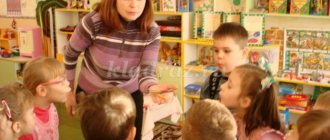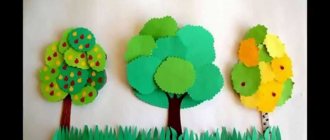Notes on activating vocabulary in the middle preschool group on the topic: Vegetables
Lesson in the middle group of a preschool educational institution
Author: Elena Valerievna Konstantinova, student at ChSPU named after.
I.Ya.Yakovleva" Cheboksary Description of the material : I offer you a summary of how to activate the vocabulary in the middle group on the topic “Vegetables.” This summary is aimed at activating the vocabulary of children 4-5 years old by guessing riddles. Goal: to enrich and improve children’s understanding of vegetables. To consolidate knowledge about the place where they grow - the vegetable garden. Reinforce the general word “vegetables”. Materials: Box, vegetables (cucumber, onion, beets) Educator : Guys, look what is that near the door? This is the package we received! Kids, do you want to know what's in the box? Children: Yes! Educator: Let's see what's inside. (The teacher takes the vegetables out of the box one at a time). What is this, guys? Children: Cucumber Teacher: What color is it? Children: Green Teacher: what is his uniform? Children: Oval Teacher: That's right, children, still elongated. Of course, you have tasted cucumber, what dishes is it most often added to? Children: In the salad. Educator : That’s right, most often they prepare a salad from cucumbers and tomatoes. What kind of red vegetable is this? Children: Beets! Educator : Of course it’s beets, look what it looks like, what is it like at the top? And below? Children: thin at the bottom with a ponytail, and fat at the top. Educator : That's right, at the bottom it is sharp like an arrow, and at the top it is wide and thick. (The teacher shakes the box a little from side to side.) Guys, is there anything left in our box? Children: Yes! Educator : Misha, look what’s there? (Misha takes out an onion from the box) Children: onion. Educator : Look at the onion, guys, what is it like? Children: It is yellow and rustling. Educator : That's right, but is it useful? Children: Yes Educator: Of course, when we are sick, we eat onions to heal. Have you ever peeled an onion? What happens when we clean it? Children: we cry Educator : That's right, onions make us cry when we peel them. What is all this called? Children: vegetables Teacher: Tell me, where do vegetables grow? Children: in the garden Teacher: That's right, in the garden, in the beds. Guys, please tell me what it is, In the green garden it has grown into the ground, It’s thick on top, sharp on the bottom, It’s red in itself. Children: Beets Educator : Right, why did you decide that? Children: grows in the ground, thick at the top, sharp at the bottom. Educator : That's right, and it's very, very green and oval, elongated. The tomato is a faithful brother, Also asking for a salad. Did you guess it? Well done! Well, of course... Children: cucumbers Educator: How did you guess? Children: Oval, elongated, used in salads Educator: Well done, guys. Now guess: Golden and healthy, Vitamin-rich, although sharp, It has a bitter taste. When you clean, you shed tears. Children: Onion Educator: That’s right, on what grounds did you decide that? Children: Golden, bitter, useful, makes you cry Educator : Good guys, we figured out everything that was in our package!
We recommend watching:
Summary of a lesson in the middle group on the works of Marshak Notes of the GCD in the middle group “Help the Cockerel” Summary of the GCD in the middle group on the topic: “Who lives in the little house?” Summary of a design lesson in the middle group "Tumbler"
Similar articles:
Math lesson “Rectangle” in the middle group of kindergarten
Vocabulary work in the middle group
Vocabulary work in the middle group.
In the middle groups, the main attention is paid to the task of accumulating and enriching the vocabulary, which is closely related to the expansion of knowledge and ideas about the environment.
Children still do not always correctly name words denoting objects. In order to teach them to correlate an object with the word that denotes it, it is important to often ask questions like: what is this?; give tasks: bring something.
In this age group, the main task is, of course, the quantitative accumulation of vocabulary, which is solved not only in classes on speech development, but also in all other types of activities.
Along with this, one should also keep in mind the solution of problems of high-quality accumulation of vocabulary, attracting children’s attention not only to the correct naming of objects, but also their qualities, properties and actions, i.e. tasks of activating in the child’s speech, in addition to nouns and adjectives, verbs. To this end, questions should be asked more often: which one? What can you do? What is he doing? You can invite children to compare objects, naming a variety of qualities. Of course, in the first lessons, children will not always be able to independently name some qualities or actions, and here the teachers help them. But it is imperative to encourage children to repeat so that the necessary words are included in their active vocabulary. Similar questions are asked when looking at paintings.
Such lexical exercises are important not only for solving problems of vocabulary accumulation, but also so that the child can use the mastered speech material to construct simple utterances.
In this group, vocabulary work is carried out with extensive use of visual aids (toys, pictures). The teacher’s speech also plays an important role as one of the important sources of enriching children’s speech. Games for which children select objects of the same generic category (toys, doll dishes, clothes) help children master general concepts.
In the middle group, the child’s active vocabulary reaches 1900–2000 words. In children's speech, the number of abbreviations, rearrangements, and omissions decreases. The child names animals and their young, people’s professions. Children use a more complicated and common phrase. There are compound and complex sentences, prepositions are used: by, before, after, instead. Unions: what, where, how much. The child understands conditional sentences with the words “if”. Speech becomes more coherent and consistent. Children learn to answer questions, retell well-known fairy tales, stories (with the help of adults). By the age of five, almost all age-related irregularities in pronunciation disappear.




